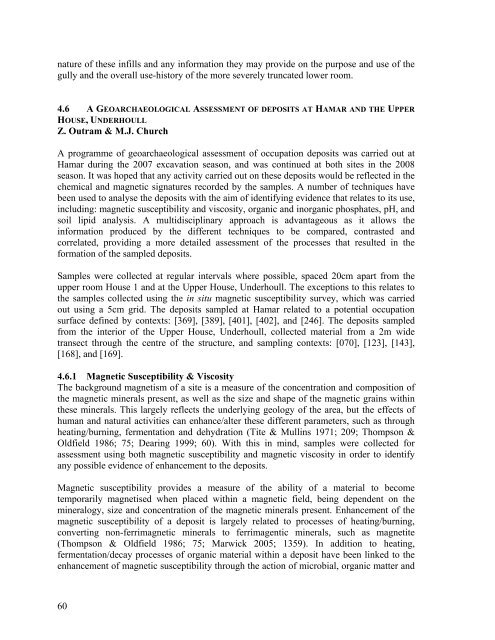VIKING UNST PROJECT: FIELD SEASON 2008 - Nabo
VIKING UNST PROJECT: FIELD SEASON 2008 - Nabo
VIKING UNST PROJECT: FIELD SEASON 2008 - Nabo
- No tags were found...
You also want an ePaper? Increase the reach of your titles
YUMPU automatically turns print PDFs into web optimized ePapers that Google loves.
nature of these infills and any information they may provide on the purpose and use of thegully and the overall use-history of the more severely truncated lower room.4.6 A GEOARCHAEOLOGICAL ASSESSMENT OF DEPOSITS AT HAMAR AND THE UPPERHOUSE, UNDERHOULLZ. Outram & M.J. ChurchA programme of geoarchaeological assessment of occupation deposits was carried out atHamar during the 2007 excavation season, and was continued at both sites in the <strong>2008</strong>season. It was hoped that any activity carried out on these deposits would be reflected in thechemical and magnetic signatures recorded by the samples. A number of techniques havebeen used to analyse the deposits with the aim of identifying evidence that relates to its use,including: magnetic susceptibility and viscosity, organic and inorganic phosphates, pH, andsoil lipid analysis. A multidisciplinary approach is advantageous as it allows theinformation produced by the different techniques to be compared, contrasted andcorrelated, providing a more detailed assessment of the processes that resulted in theformation of the sampled deposits.Samples were collected at regular intervals where possible, spaced 20cm apart from theupper room House 1 and at the Upper House, Underhoull. The exceptions to this relates tothe samples collected using the in situ magnetic susceptibility survey, which was carriedout using a 5cm grid. The deposits sampled at Hamar related to a potential occupationsurface defined by contexts: [369], [389], [401], [402], and [246]. The deposits sampledfrom the interior of the Upper House, Underhoull, collected material from a 2m widetransect through the centre of the structure, and sampling contexts: [070], [123], [143],[168], and [169].4.6.1 Magnetic Susceptibility & ViscosityThe background magnetism of a site is a measure of the concentration and composition ofthe magnetic minerals present, as well as the size and shape of the magnetic grains withinthese minerals. This largely reflects the underlying geology of the area, but the effects ofhuman and natural activities can enhance/alter these different parameters, such as throughheating/burning, fermentation and dehydration (Tite & Mullins 1971; 209; Thompson &Oldfield 1986; 75; Dearing 1999; 60). With this in mind, samples were collected forassessment using both magnetic susceptibility and magnetic viscosity in order to identifyany possible evidence of enhancement to the deposits.Magnetic susceptibility provides a measure of the ability of a material to becometemporarily magnetised when placed within a magnetic field, being dependent on themineralogy, size and concentration of the magnetic minerals present. Enhancement of themagnetic susceptibility of a deposit is largely related to processes of heating/burning,converting non-ferrimagnetic minerals to ferrimagentic minerals, such as magnetite(Thompson & Oldfield 1986; 75; Marwick 2005; 1359). In addition to heating,fermentation/decay processes of organic material within a deposit have been linked to theenhancement of magnetic susceptibility through the action of microbial, organic matter and60
















